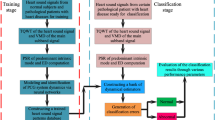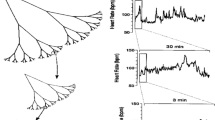Abstract
The early and accurate diagnosis of cardiovascular diseases (CVDs) are of great importance as they allow early and proper medical treatment and therefore result in reducing the chance of the CVDs being developed to an acute level. In medical procedures, the first step in examining the cardiovascular function is the auscultation of the heart. However, the correct medical diagnosis based on the heart sounds through a stethoscope requires a lot of expertise and, in some cases, needs referral of the patient to a cardiologist. This is not only time-consuming but also imposes a financial burden on the medical system. Thus, automated detection and analysis of the recorded heart sound auscultation has received a lot of attentions in recent years. This study presents a new time–frequency (T–F) based approach for classifying phonocardiogram (PCG) signals into normal and abnormal. In the proposed methodology, each PCG recording is first segmented into the 4 fundamental heart cycles, i.e. S1, systole, S2, and diastole. From each state, a set of T–F features are extracted with the aim of identifying their characteristics in the T–F domain. The features are then applied to a support vector machine to classify the PCG signal into normal or abnormal. The performance of the proposed method is evaluated using the 2016 PhysioNet challenge database and compared with that of the best performing existing methods. The experimental results using tenfold cross-validation show that the proposed method outperforms the existing methods in terms of sensitivity, specificity, and accuracy.


Similar content being viewed by others

Availability of data and material
Not applicable.
Code availability
Not applicable.
References
Virani, S. S., Alonso, A., Benjamin, E. J., Bittencourt, M. S., Callaway, C. W., Carson, A. P., et al. (2020). Heart disease and stroke statistics—2020 update: a report from the American Heart Association. Circulation, 141, E139–E596
Weir, H. K., Anderson, R. N., King, S. M. C., Soman, A., Thompson, T. D., Hong, Y., et al. (2016). Peer reviewed: heart disease and cancer deaths—Trends and projections in the United States, 1969–2020. Preventing Chronic Disease, 13, E157
Kusumoto, F. (2020). ECG interpretation: From pathophysiology to clinical application. Springer Nature.
Hanna, I. R., & Silverman, M. E. (2002). A history of cardiac auscultation and some of its contributors. The American Journal of Cardiology, 90(3), 259–267
Quiceno-Manrique, A., Godino-Llorente, J., Blanco-Velasco, M., & Castellanos-Dominguez, G. (2010). Selection of dynamic features based on time–frequency representations for heart murmur detection from phonocardiographic signals. Annals of Biomedical Engineering, 38(1), 118–137
Chowdhury, M. E., Khandakar, A., Alzoubi, K., Mansoor, S., Tahir, A. M., Reaz, M. B. I., et al. (2019). Real-time smart-digital stethoscope system for heart diseases monitoring. Sensors, 19(12), 2781
Nabih-Ali, M., El-Dahshan, E.-S.A., & Yahia, A. S. (2017). A review of intelligent systems for heart sound signal analysis. Journal of Medical Engineering & Technology, 41(7), 553–563
Lin, Y.-J., Chuang, C.-W., Yen, C.-Y., Huang, S.-H., Huang, P.-W., Chen, J.-Y., et al. (2019). An intelligent stethoscope with ECG and heart sound synchronous display. In 2019 IEEE international symposium on circuits and systems (ISCAS) (pp. 1–4). IEEE.
Shi, W., & Chiao, J.-C. (2018). Neural network based real-time heart sound monitor using a wireless wearable wrist sensor. Analog Integrated Circuits and Signal Processing, 94(3), 383–393
Khan, M. F., Atteeq, M., & Qureshi, A. N. (2019). Computer aided detection of normal and abnormal heart sound using PCG. In Proceedings of the 2019 11th international conference on bioinformatics and biomedical technology (pp. 94–99).
Sattar, F., Jin, F., Moukadem, A., Brandt, C., & Dieterlen, A. (2016). Time-scale-based segmentation for degraded PCG signals using NMF. In Non-negative matrix factorization techniques (pp. 179–194) Springer.
Kumar, D., Carvalho, P., Antunes, M., Henriques, J., Eugenio, L., Schmidt, R., et al. (2006). Detection of S1 and S2 heart sounds by high frequency signatures. In 2006 international conference of the IEEE engineering in medicine and biology society (pp. 1410–1416). IEEE.
Othman, M. Z., & Khaleel, A. N. (2017). Phonocardiogram signal analysis for murmur diagnosing using Shannon energy envelop and sequenced DWT decomposition. Journal of Engineering Science and Technology, 12(9), 2393–2402
White, P., Collis, W., & Salmon, A. (1997). Time-frequency analysis of heart murmurs in children.
Malarvili, M., Kamarulafizam, I., Hussain, S., & Helmi, D. (2003). Heart sound segmentation algorithm based on instantaneous energy of electrocardiogram. In Computers in cardiology, 2003 (pp. 327–330). IEEE.
Rajankar, S. O., & Talbar, S. N. (2019). An electrocardiogram signal compression techniques: A comprehensive review. Analog Integrated Circuits and Signal Processing, 98(1), 59–74
Whitaker, B. M., Suresha, P. B., Liu, C., Clifford, G. D., & Anderson, D. V. (2017). Combining sparse coding and time-domain features for heart sound classification. Physiological Measurement, 38(8), 1701
Gopika, P., Sowmya, V., Gopalakrishnan, E., & Soman, K. (2019). Performance improvement of deep learning architectures for phonocardiogram signal classification using fast fourier transform. In 2019 9th international conference on advances in computing and communication (ICACC) (pp. 290–294). IEEE.
Boutana, D., Benidir, M., & Barkat, B. (2011). Segmentation and identification of some pathological phonocardiogram signals using time-frequency analysis. IET Signal Processing, 5(6), 527–537
Vernekar, S., Nair, S., Vijaysenan, D., & Ranjan, R. (2016). A novel approach for classification of normal/abnormal phonocardiogram recordings using temporal signal analysis and machine learning. In 2016 computing in cardiology conference (CinC) (pp. 1141–1144). IEEE.
Rubin, J., Abreu, R., Ganguli, A., Nelaturi, S., Matei, I., & Sricharan, K. (2016). Classifying heart sound recordings using deep convolutional neural networks and mel-frequency cepstral coefficients. In 2016 computing in cardiology conference (CinC) (pp. 813–816). IEEE.
Ortiz, J. J. G., Phoo, C. P., & Wiens, J. (2016). Heart sound classification based on temporal alignment techniques. In 2016 computing in cardiology conference (CinC) (pp. 589–592). IEEE.
Meintjes, A., Lowe, A., & Legget, M. (2018). Fundamental heart sound classification using the continuous wavelet transform and convolutional neural networks. In 2018 40th annual international conference of the IEEE engineering in medicine and biology society (EMBC) (pp. 409–412). IEEE.
Zabihi, M., Rad, A. B., Kiranyaz, S., Gabbouj, M., & Katsaggelos, A. K. (2016). Heart sound anomaly and quality detection using ensemble of neural networks without segmentation. In 2016 computing in cardiology conference (CinC) (pp. 613–616). IEEE.
Nilanon, T., Yao, J., Hao, J., Purushotham, S., & Liu, Y. (2016). Normal/abnormal heart sound recordings classification using convolutional neural network. In 2016 computing in cardiology conference (CinC) (pp. 585–588). IEEE.
Grzegorczyk, I., Soliński, M., Łepek, M., Perka, A., Rosiński, J., Rymko, J., et al. (2016). PCG classification using a neural network approach. In 2016 computing in cardiology conference (CinC) (pp. 1129–1132). IEEE.
Potes, C., Parvaneh, S., Rahman, A., & Conroy, B. (2016). Ensemble of feature-based and deep learning-based classifiers for detection of abnormal heart sounds. In 2016 computing in cardiology conference (CinC) (pp. 621–624). IEEE.
Goda, M. A., & Hajas, P. (2016). Morphological determination of pathological PCG signals by time and frequency domain analysis. In 2016 computing in cardiology conference (CinC) (pp. 1133–1136). IEEE.
Springer, D. B., Tarassenko, L., & Clifford, G. D. (2015). Logistic regression-HSMM-based heart sound segmentation. IEEE Transactions on Biomedical Engineering, 63(4), 822–832
Clifford, G. D., Liu, C., Moody, B., Springer, D., Silva, I., Li, Q., et al. (2016). Classification of normal/abnormal heart sound recordings: The PhysioNet/Computing in Cardiology Challenge 2016. In 2016 computing in cardiology conference (CinC) (pp. 609–612). IEEE.
Liu, C., Springer, D., Li, Q., Moody, B., Juan, R. A., Chorro, F. J., et al. (2016). An open access database for the evaluation of heart sound algorithms. Physiological Measurement, 37(12), 2181
Liu, C., Springer, D., & Clifford, G. D. (2017). Performance of an open-source heart sound segmentation algorithm on eight independent databases. Physiological Measurement, 38(8), 1730
Debbal, S., & Bereksi-Reguig, F. (2008). Computerized heart sounds analysis. Computers in Biology and Medicine, 38(2), 260–283
Hassani, K., Bajelani, K., Navidbakhsh, M., & Doyle, J. (2014). Detection and identification of S1 and S2 heart sounds using wavelet decomposition and reconstruction. In XIII Mediterranean conference on medical and biological engineering and computing 2013 (pp. 509–514). Springer.
Boashash, B., Azemi, G., & O’Toole, J. M. (2013). Time-frequency processing of nonstationary signals: Advanced TFD design to aid diagnosis with highlights from medical applications. IEEE Signal Processing Magazine, 60(3), 108–119
Boashash, B. (2015). Time-frequency signal analysis and processing: A comprehensive reference. Academic Press.
Boashash, B., Azemi, G., & Khan, N. A. (2015). Principles of time–frequency feature extraction for change detection in non-stationary signals: Applications to newborn EEG abnormality detection. Pattern Recognition, 48(3), 616–627
Funding
Not applicable.
Author information
Authors and Affiliations
Contributions
H.H.: Methodology, Software, Writing—Original draft preparation; P.Z.: Supervision, Writing—Reviewing and Editing; G.A.: Supervision, Methodology, Formal analysis, Writing—Reviewing and Editing.
Corresponding author
Ethics declarations
Conflict of interests
The authors declare that they have no known competing financial interests or personal relationships that could have appeared to influence the work reported in this paper.
Additional information
Publisher's Note
Springer Nature remains neutral with regard to jurisdictional claims in published maps and institutional affiliations.
Rights and permissions
About this article
Cite this article
Hazeri, H., Zarjam, P. & Azemi, G. Classification of normal/abnormal PCG recordings using a time–frequency approach. Analog Integr Circ Sig Process 109, 459–465 (2021). https://doi.org/10.1007/s10470-021-01867-2
Received:
Revised:
Accepted:
Published:
Issue Date:
DOI: https://doi.org/10.1007/s10470-021-01867-2



